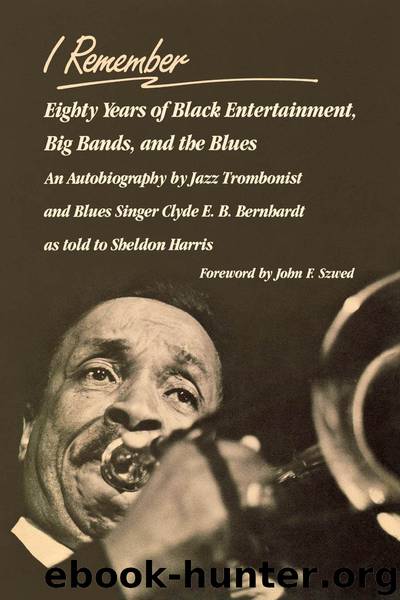The Game Changer by A. G. Lafley

Author:A. G. Lafley [Lafley, A. G.]
Language: eng
Format: epub
Publisher: Profile
Published: 1986-02-15T05:00:00+00:00
20. Edgar Hayes’ Orchestra, 1937–1942
I left Vernon Andrade Sunday night, February 21, 1937, and Edgar Hayes immediately hired me, and by Wednesday we all in Philadelphia working some weekend jobs.
The next time I saw Andrade was in the Alhambra Ballroom where Hayes was rehearsing.
“Barnhardt,” he said, “I made a mistake when I let you go.”
“No, Vernon,” I interrupted, “it was no mistake. You did me the biggest favor you could of done for me.”
And that was true. I was now with another good band—do whatever I wanted, when I wanted. And damn sure wasn’t scared of the boss.
I liked the sound of the new Hayes orchestra: swing, jazz, sweet, popular, everything well balanced in a style between Jimmie Lunceford and Duke Ellington.
Hayes had one hell of a book—all original arrangements and very tough. We rehearsed those difficult numbers over and over, some seven or eight times until we got it just like he wanted. But once we got it down, we were a smash. Count Basie always said Hayes didn’t know how great he really was—he often hired Edgar as his rehearsal leader and then go home and leave him in charge.
Like the guys used to say, the Hayes band was the “college,” and when you came out of there it was like graduating. You go anywhere after that.
Hayes was also a hell of a pianist—played everything, even the classics. Played great stride just like James P. Johnson and had the articulation of Earl Hines. To me he was one of the greatest piano players and band leaders in the business.
This was the line-up when I joined. I’ll start with the trombone section: R. H. Horton—we called him Robert but his real name was Redius—was the same man I heard in Sam Wooding’s band back in 1923; Wilbur De Paris was there too, but David “Jelly” James replaced him after a few weeks. Jelly and I handled both first and second trombone parts.
Scad Hemphill was first trumpet. I remember he was always laughing, like a old Cheshire cat, especially at how people all dressed—hell, I thought he looked like a damn dressed-up groundhog himself.
Bernard Flood was second trumpet and Henry Goodwin, third with some jazz solos; Joe Garland, tenor; and Tab Smith, first alto, but Rudy Powell came in from Fats Waller to replace Smith after a few weeks when Tab went back to Lucky.
Crawford Wethington was third alto and Roger Boyd, fourth; Kenny Clarke, drums; Elmer James, he pick and slap string bass very well; Andy Jackson, guitar; and Edgar on piano. A solid fourteen-piece band.
Joe Garland wrote and arranged many of the numbers including In the Mood that Hayes recorded in 1938. That piece was heavy music—had four big manuscript pages just for the trombone parts. We called it his Black Symphony. When Glenn Miller heard the song, he had Garland put stop breaks in, cut out some parts, and recorded his own big hit the following year.
A lot of people tried to put a claim on that number, but after a lawsuit, Garland won out.
Download
This site does not store any files on its server. We only index and link to content provided by other sites. Please contact the content providers to delete copyright contents if any and email us, we'll remove relevant links or contents immediately.
Hit Refresh by Satya Nadella(8854)
The Compound Effect by Darren Hardy(8508)
Change Your Questions, Change Your Life by Marilee Adams(7372)
Nudge - Improving Decisions about Health, Wealth, and Happiness by Thaler Sunstein(7242)
The Black Swan by Nassim Nicholas Taleb(6763)
Deep Work by Cal Newport(6563)
Daring Greatly by Brene Brown(6222)
Rich Dad Poor Dad by Robert T. Kiyosaki(6174)
Principles: Life and Work by Ray Dalio(5961)
Man-made Catastrophes and Risk Information Concealment by Dmitry Chernov & Didier Sornette(5646)
Playing to Win_ How Strategy Really Works by A.G. Lafley & Roger L. Martin(5497)
Digital Minimalism by Cal Newport;(5389)
Big Magic: Creative Living Beyond Fear by Elizabeth Gilbert(5351)
The Myth of the Strong Leader by Archie Brown(5237)
The Slight Edge by Jeff Olson(5200)
Discipline Equals Freedom by Jocko Willink(5157)
The Motivation Myth by Jeff Haden(5003)
Stone's Rules by Roger Stone(4857)
The Laws of Human Nature by Robert Greene(4772)
